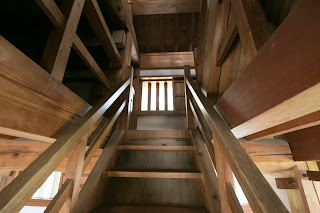Nishio Castle
-Castle had main tower in secondary area-
Overview
Name: Nishio castle (Nishio-jo)
Alias: Tsuru-jo (Crane castle)
Place: Kinjo-cho Nishio city, Aichi
Location: 34.86647935431515, 137.04762058893974
Type: Hill castle
Built: Originally in 13th century, expanded in 16th century
Remaining remnants: Stone walls, clay walls and moats
Title:
Nishio castle (西尾城) is located at an edge of low height terrace at the west of current Nishio city central. Nishio city stands at the flat area between old stream and new stream of Yahagi river, and known for its traditional town and culture.
In the medieval era, Saijo clan, a branch house of Ashikaga clan which later became a house of Muromachi Shogunate, built Saijo castle and located here in 13th century. Saijyo clan changed their name to Kira clan, and even though they did not have power but was treated as a house of prestige relates to Muromachi shogunate.
After the battle of Okehazama at 1600, Ieyasu Tokugawa (1543-1616), a warlord of Mikawa province (eastern half of Aichi prefecture), captured this castle from Kira clan. Under the commanders of Tokugawa clan, this castle was expanded by 1585, as a basis of governing this area.
In addition to this, after the transfer of Tokugawa clan to Kanto region in 1990 under Toyotomi government, Yoshimasa Tanaka (1548-1609) was appointed as a commander along with Okazaki castle, and transformed Nisnio castle into a modern one.
Throughout Edo era, like other castles in Mikawa country, Nishio castle was managed by small hereditary loads of Tokugawa clan. On and after the mid of Edo era, Ogyu Matsudaira clan which was a distinguished relative of Edo Shogunate served as a commander.
Nishio castle consisted of central area on the hill and surrounding outer areas. At first a three story main tower was built in central area, but later Yoshimasa Tanaka also built a three story but much larger new main tower in central area. Further this new main tower was transferred to the edge of secondary area, facing front side of castle.
The reason of this exceptional treatment is unclear, but assumed no space for expansion in main area, or to show the authority of lord to people effectively. Nishio castle had one main tower, another three story turret and 10 corner turrets, and well equipped considering its size and territory of the lord.
Subsequent to Meiji revolution outer areas and all buildings were lost, but inner areas are used as a park and two gates still remain. In 1996, three story turret in central area and main gate to secondary area was reconstructed, and in 2014, the base of main tower and stone walls of secondary area were also rebuilt.
15 minutes walk from Meitetsu Nishio line Nishio station. 40 minutes drive from Ise-Wangan Expressway Toyota-minami interchange.
Okazaki Castle -Hardship history of young Ieyasu Tokugawa-
Ogyu Castle -Combination of huge rocks and stone walls-
Type: Hill castle
Built: Originally in 13th century, expanded in 16th century
Remaining remnants: Stone walls, clay walls and moats
Title:
Brief History
Nishio castle (西尾城) is located at an edge of low height terrace at the west of current Nishio city central. Nishio city stands at the flat area between old stream and new stream of Yahagi river, and known for its traditional town and culture.
Build and expansion of Nishio castle
In the medieval era, Saijo clan, a branch house of Ashikaga clan which later became a house of Muromachi Shogunate, built Saijo castle and located here in 13th century. Saijyo clan changed their name to Kira clan, and even though they did not have power but was treated as a house of prestige relates to Muromachi shogunate.
After the battle of Okehazama at 1600, Ieyasu Tokugawa (1543-1616), a warlord of Mikawa province (eastern half of Aichi prefecture), captured this castle from Kira clan. Under the commanders of Tokugawa clan, this castle was expanded by 1585, as a basis of governing this area.
In addition to this, after the transfer of Tokugawa clan to Kanto region in 1990 under Toyotomi government, Yoshimasa Tanaka (1548-1609) was appointed as a commander along with Okazaki castle, and transformed Nisnio castle into a modern one.
Throughout Edo era, like other castles in Mikawa country, Nishio castle was managed by small hereditary loads of Tokugawa clan. On and after the mid of Edo era, Ogyu Matsudaira clan which was a distinguished relative of Edo Shogunate served as a commander.
Structure of Nishio castle
Nishio castle consisted of central area on the hill and surrounding outer areas. At first a three story main tower was built in central area, but later Yoshimasa Tanaka also built a three story but much larger new main tower in central area. Further this new main tower was transferred to the edge of secondary area, facing front side of castle.
The reason of this exceptional treatment is unclear, but assumed no space for expansion in main area, or to show the authority of lord to people effectively. Nishio castle had one main tower, another three story turret and 10 corner turrets, and well equipped considering its size and territory of the lord.
Subsequent to Meiji revolution outer areas and all buildings were lost, but inner areas are used as a park and two gates still remain. In 1996, three story turret in central area and main gate to secondary area was reconstructed, and in 2014, the base of main tower and stone walls of secondary area were also rebuilt.
Access
15 minutes walk from Meitetsu Nishio line Nishio station. 40 minutes drive from Ise-Wangan Expressway Toyota-minami interchange.
Related Castles
Okazaki Castle -Hardship history of young Ieyasu Tokugawa-
Ogyu Castle -Combination of huge rocks and stone walls-




































































































































nice
ReplyDelete